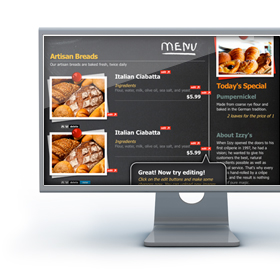Making CMS Work For Your Design
by 31 May, 2011 9:18 am0
The days of static websites are over, or at least they should be. But there are still many web designers/developers building static sites for paying customers. The reasons usually boil down to one or more of the following:
– Building a CMS site is too hard/too much work
– The work involved is too expensive for my clients
– The CMS frameworks are all too rigid from a design standpoint
– You have to be a programmer to get a truly custom solution
– The client didn’t ask for it/doesn’t know what it is

There are products out there that solve all of these problems and this article will focus on one in particular: MagicEdit. I’m not saying it’s the best or only solution out there, but it is the easiest and least intrusive to the designer’s workflow. The way it works is quite simple, actually; you build a site using standard HTML and add tags to whatever you want to be editable. There are several other CMS solutions out there that also do this, but what sets MagicEdit apart is that the content manager makes the changes onsite, on the actual page that they want to edit. The tags are as simple as wrapping a div with
Does it cost money? Yes. It costs a little more than standard hosting, but MagicEdit manages all the files and you never have to worry about software or security updates, system upgrades, new features, etc. Since everything lives on their servers, the program always includes the latest features. Besides, if the client is going to be managing all the content, it saves them from having to hire an HTML expert or call you to make tiny changes to the site that they should really be able to do themselves.
The biggest advantage for the web designer is the freedom MagicEdit allows. You can start a site from scratch and embed the CMS as needed, or convert existing HTML into a full-blown CMS site in less time than it takes to have a pizza delivered. Your limits are literally just the HTML and the CSS, as even the MagicEdit buttons and controls are customizable.
 If you’re not into PHP programming (or don’t like copy-pasting scripts of unknown origin), then you really need to use MagicEdit. All the programming is built in, from client login to form processing. There are no massive file directories to copy over since everything runs inside the program. All you have to do to build a contact form is design it.
If you’re not into PHP programming (or don’t like copy-pasting scripts of unknown origin), then you really need to use MagicEdit. All the programming is built in, from client login to form processing. There are no massive file directories to copy over since everything runs inside the program. All you have to do to build a contact form is design it.
If your client didn’t ask for a CMS, maybe he or she doesn’t know what it is. If you are the kind-hearted web designer that explains it (and shows how easy it is to use), you may have just guaranteed yourself a job. Being able to offer it and include the cost of hosting is an added bonus.
If you want to offer your clients a fully-featured CMS that’s dead simple to implement and even easier to use, you should start with MagicEdit. Don’t change your workflow to fit around a CMS. Use a CMS that fits into your workflow.

This article was written by Justin Parsons.




































































